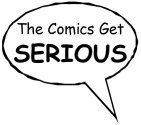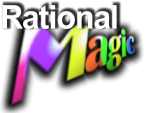

| Valerian: Heroes of the Equinox. By J. C. Mezieres and P. Christin. Translated by E. Tran-Le. New York: Dargaud International Publishing, 1983. 48p. $6.95. ISBN 0-918348-68-4. |

|
GENRES: AUDIENCE: NOTE: Although I reviewed the Valerian series in my book and mentioned this title, I didn't review it specifically, as I only managed to get a copy last year. SYNOPSIS: At the arena, the four champions show their prowess. Irmgaal, from Krahan, "Planet of the Great Black Warriors," does a passable Thor imitation with "Zarkam," his invincible sword, and destroys a giant rock. Ortzog, chain-wearing Communistic delegate from "industrious Bourgnouf," knocks over a huge column. Blimflim, carrot-top-helmeted, agrarian wizard from "iridescent Malamum," uses plants to destroy another column. Finally, Valerian, with no idea what to do, uses his laser to knock off one small stone decoration. "At least this one's less wasteful," comments an unimpressed oldster. With fanfare, the four champions fly off to Filene--Valerian's propulsion device is barely adequate to the task. When they arrive, he suggests a nap, but the three alien bombasts (who sound like Huey, Dewey, and Louie as they finish one anothers' sentences) insist on commencing the three-day struggle immediately. Each sets off in a different direction. Irmgaal must navigate raging flames and lava; Ortzog, ice; Blimflim, a desert; and Valerian, a mountain and then a series of caverns into which he falls, lit only by his small helmet lamp. At the fall of the first day, the champions pitch camp, and Laureline wonders about the fate of her partner. The second day brings trials from "the vegetable realm," as the champions battle monsters (Irmgaal and Ortzog), try to get animals to cooperate (Blimflim), or fight off rats (Valerian). Valerian is feeling distinctly un-heroic and merely wants to find his way out of the caverns. On the third day, the three alien champions reach the summit of a mountain at the same time and spend their time pounding on each other until stopped by an old man, who explains their third task: they must tell him how they each view Simlane's future if they win, and the old man will turn their words into images. Irmgaal sees the planet becoming a glorious militaristic society that conquers everything around it. Ortzog envisions a world of perfect order and conformity, with "useless luxury buildings" demolished to make way for heavy industry and intensive agricultural development. Blimflim would see all trappings of civilization erased to make way for a "modest," inward-looking agrarian society. At this point, Valerian emerges, confused and exhausted and blinded by the sunlight. The old man asks him to share his view of what Simlane might be if he wins. Totally unprepared for this, Valerian projects funny colors as he admits that he has no idea, and anyway, "it's not up to me to define Simlane's future. I hope these people will be happy in their own way on their own planet." (At this, Blimflim scoffs, "All the visionary's fit to sire is morons.") Another night passes; Valerian sleeps while the others eat and drink. In the morning, the old man returns with a decision: She has chosen Valerian. The other three, scandalized, are returned to the mainland via whirlwind. She turns out to be the Supreme Mother of Simlane, a beautiful goddess, and promises immortality to Valerian for spawning the next generation of Simlane children, who will "rebuild its city and paint it in colors as joyous as those in your funny visions." Unfortunately, becoming the champion also means never returning from Filene, something Laureline knows all too well. When the three losing champions are deposited on the shores of Simlane's city, she undertakes the journey to the island to see whether Valerian was killed. He hasn't been killed... but he has a little problem now.... EVALUATION: This, dear readers, is a major shame. Those of us not fortunate enough to be bilingual in French are missing out on some outstanding comics work, if the few translated Valerians--specifically Heroes of the Equinox for the moment--are any judge. First, the writing. The translation is excellent, much better than the one I remember from World Without Stars. There are almost no awkward moments. The story is a huge satire of heroic quests, and there is considerable amusing contrast between the three different-but-similar superhero-type aliens and the realistic, vulnerable Valerian. The three aliens know, of course, that they're participating in a contest of utmost importance, whereas Valerian is willing to compete but out of duty, not out of a desire to shape a planet. They have deliberately two-dimensional, nonrealistic personalities--as I mentioned above, they often finish one anothers' sentences, walk in step, and pose in a line together. On the other hand, the aliens are allowed some unguarded moments "out of the spotlight" when, as individuals, they stop for the night: Irmgaal yells at his sword for overcooking his food, Ortzog is relieved to take off his tight girdle and resolves to get a bigger one, and Blimflim reads a recipe book. The story is also well paced--one of the best-paced I've seen in a while, actually. Nothing is overplayed; each moment or incident gets exactly the right amount of attention, notably the scenes of combat. In an American graphic novel, such scenes would have been twice as long, if not more, and in manga, forget it, I'd still be trying to differentiate the action from the special effects. But in this book, action and combat exist only long enough to serve their purpose. (Indeed, the scene where the three aliens fught each other is a satire on similar scenes in superhero books; note that none of the characters suffer the slightest physical damage or even disarray from all the pounding, which only serves to highlight their detachment from Valerian's reality.) Now, the art. Mezieres is, in a word, stunning. The variety of images, both of people and of backgrounds, is enormous. Even in relatively small panels, he manages to convey a sense of wonder about the beautiful alien landscape of Simlane. The three aliens are simultaneously impressive and ridiculous, with their silly superhero-style costumes (Blimflim's carrot-helmet is probably the silliest appurtenance). There are occasional satiric nods to American superhero art, such as the panel where the aliens take off; Irmgaal is flying away in a classic Superman pose. (And just to make the point stick, commentary on their takeoff includes "Those four are fantastic!" "Yes, really super, those heroes!") Even the lettering adds to the overall effect; the three aliens speak using typical incorrectly overemphasized words, whereas Valerian speaks in a "normal" tone of voice.
The Valerian books should be a core part of any European-focused connection and would make lovely additions to other collections. The stories might be a little more subtle than kids would prefer, but they're otherwise appropriate for that age group (at least the ones I've seen, this one and World Without Stars). Budding comics artists and science fiction/fantasy writers would do well to investigate this series! |
||||||
Return to Rational Magic Home
